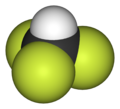Top Qs
Timeline
Chat
Perspective
Fluoroform
Chemical compound From Wikipedia, the free encyclopedia
Remove ads
Fluoroform, or trifluoromethane, is the chemical compound with the formula CHF3. It is a hydrofluorocarbon as well as being a part of the haloforms, a class of compounds with the formula CHX3 (X = halogen) with C3v symmetry. Fluoroform is used in diverse applications in organic synthesis. It is not an ozone depleter but is a greenhouse gas.[2]
Remove ads
Synthesis
About 20 million kg per year are produced industrially as both a by-product of and precursor to the manufacture of Teflon.[2] It is produced by reaction of chloroform with HF:[3]
- CHCl3 + 3 HF → CHF3 + 3 HCl
It is also generated biologically in small amounts apparently by decarboxylation of trifluoroacetic acid.[4]
Historical
Fluoroform was first obtained by Maurice Meslans in the violent reaction of iodoform with dry silver fluoride in 1894.[5] The reaction was improved by Otto Ruff by substitution of silver fluoride by a mixture of mercury fluoride and calcium fluoride.[6] The exchange reaction works with iodoform and bromoform, and the exchange of the first two halogen atoms by fluorine is vigorous. By changing to a two step process, first forming a bromodifluoromethane in the reaction of antimony trifluoride with bromoform and finishing the reaction with mercury fluoride the first efficient synthesis method was found by Henne.[6]
Remove ads
Industrial applications
CHF3 is used in the semiconductor industry in plasma etching of silicon oxide and silicon nitride. Known as R-23 or HFC-23, it was also a useful refrigerant, sometimes as a replacement for chlorotrifluoromethane (CFC-13) and is a byproduct of its manufacture.
When used as a fire suppressant, the fluoroform carries the DuPont trade name, FE-13. CHF3 is recommended for this application because of its low toxicity, its low reactivity, and its high density. HFC-23 has been used in the past as a replacement for Halon 1301(CFC-13B1) in fire suppression systems as a total flooding gaseous fire suppression agent.
Organic chemistry
Fluoroform is weakly acidic with a pKa = 25–28 and quite inert. Attempted deprotonation results in defluorination to generate F− and difluorocarbene (CF2). Some organocopper and organocadmium compounds have been developed as trifluoromethylation reagents.[7]
Fluoroform is a precursor of the Ruppert-Prakash reagent CF3Si(CH3)3, which is a source of the nucleophilic CF−3 anion.[8][9]
Remove ads
Greenhouse gas
Summarize
Perspective


CHF3 is a potent greenhouse gas. A ton of HFC-23 in the atmosphere has the same effect as 11,700 tons of carbon dioxide. This equivalency, also called a 100-yr global warming potential, is slightly larger at 14,800 for HFC-23.[10] The atmospheric lifetime is 270 years.[10]
HFC-23 was the most abundant HFC in the global atmosphere until around 2001, when the global mean concentration of HFC-134a (1,1,1,2-tetrafluoroethane), the chemical now used extensively in automobile air conditioners, surpassed those of HFC-23. Global emissions of HFC-23 have in the past been dominated by the inadvertent production and release during the manufacture of the refrigerant HCFC-22 (chlorodifluoromethane).
Substantial decreases in HFC-23 emissions by developed countries were reported from the 1990s to the 2000s: from 6-8 Gg/yr in the 1990s to 2.8 Gg/yr in 2007.[11]
However, research in 2024 strongly indicates that the HFC-23 emission decrease is much less than has been reported and does not meet the internationally agreed Kigali Amendment of 2020.[12][13]
The UNFCCC Clean Development Mechanism provided funding and facilitated the destruction of HFC-23.
Developing countries have become the largest producers of HCFC-23 in recent years according to data compiled by the Ozone Secretariat of the World Meteorological Organization.[14][15][16] Emissions of all HFCs are included in the UNFCCCs Kyoto Protocol. To mitigate its impact, CHF3 can be destroyed with electric plasma arc technologies or by high temperature incineration.[17]
Additional physical properties
Remove ads
References
Literature
External links
Wikiwand - on
Seamless Wikipedia browsing. On steroids.
Remove ads



